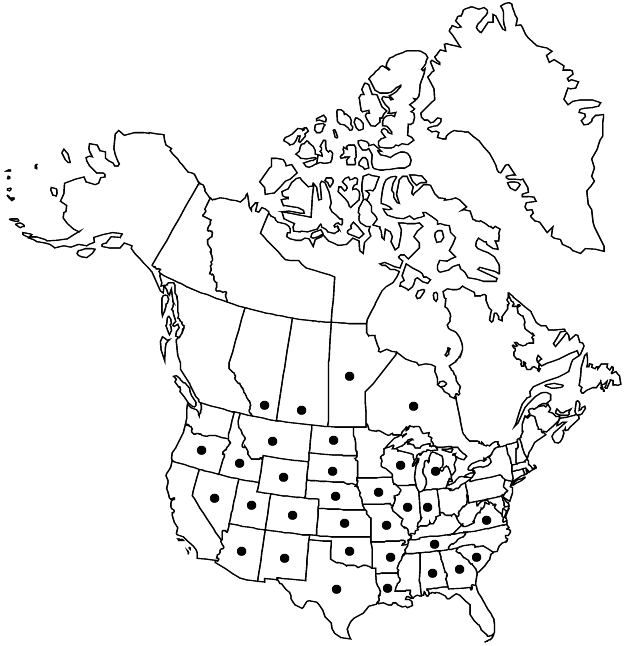Cerastium brachypodum
Mem. Torrey Bot. Club 5(Sig. 10): 150. 27 Apr 1894.
Plants annual, with filiform taproot. Stems erect, simple or several from branched caudex, 5–20 cm, glandular-pubescent, nodes without long, wooly hairs; small axillary tufts of leaves absent. Leaves sessile, not marcescent, usually confined to proximal 1/2 of plant; midstem leaves with blade lanceolate to narrowly elliptic or oblanceolate, 5–30 × 2–8 mm, apex ± acute, usually rather sparsely, softly pubescent; proximal leaves sometimes forming loose rosette, blade ovate to obovate or spatulate, apex ± obtuse. Inflorescences compact to open, dichotomous, 3–30-flowered cymes, confined to distal portion of stem; bracts herbaceous, lanceolate, glandular-puberulent. Pedicels often becoming deflexed at base, 3–10 (–12) mm, 0.5–1.25 times as long as sepals in flower, elongating to equaling capsule, glandular-pubescent. Flowers: sepals broadly lanceolate, 3–4.5 mm, apex subacute, glandular-puberulent to glabrate, hairs shorter than sepal tip, outer sepals herbaceous or with narrow margins, inner with broad margins; petals ovate-elliptic, 3–4 mm, equaling or shorter than sepals, apex 2-fid; stamens 10; styles 5. Capsules cylindric, curved, 6–12 mm, 2–2.25 times as long as sepals; teeth 10, erect, margins convolute. Seeds golden brown, 0.4–0.7 mm diam., tuberculate, especially around edge; testa not inflated. 2n = 34.
Phenology: Flowering spring and early summer.
Habitat: Grasslands, fields, meadows, open woods, roadsides, waste places, often in seasonally wet rocky or sandy ground
Elevation: 100-2700 m
Distribution

Alta., Man., Ont., Sask., Ala., Ariz., Ark., Colo., Ga., Idaho, Ill., Ind., Iowa, Kans., La., Mich., Mo., Mont., Nebr., Nev., N.Mex., N.Dak., Okla., Oreg., S.C., S.Dak., Tenn., Tex., Utah, Va., Wis., Wyo., Mexico
Discussion
Cerastium brachypodum differs from C. nutans in its smaller size; its short pedicels, which often become deflexed at the base instead of near the capsule; and its pubescence, which is usually sparser and lacks any long, lanate hairs. However, some specimens from the arid region of the southwest have a dense gray pubescence. Plants from the Arizona desert, which have particularly long and narrow capsules, are the basis for the erroneous report of C. gracile Dufour from that region.
Cerastium fastigiatum can be very similar to C. brachypodum but differs in its longer pedicels, narrowly acute leaves, glandular pubescence on the stems, and much more branched (fastigiate) habit.
Selected References
None.
Lower Taxa
"-2.25timesaslongassepals" is not declared as a valid unit of measurement for this property."elongating" is not a number."-1.25timesaslongassepals" is not declared as a valid unit of measurement for this property.
